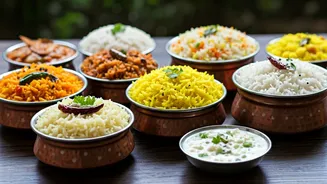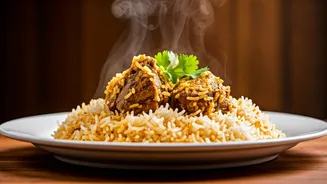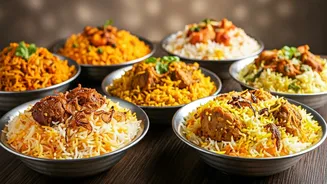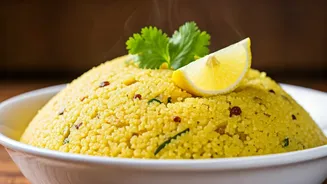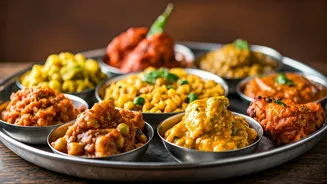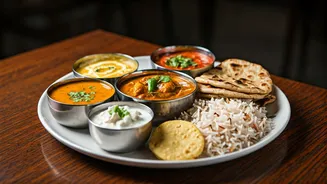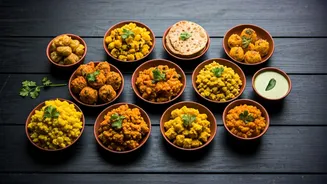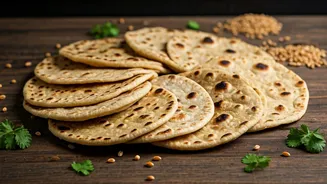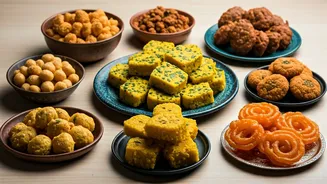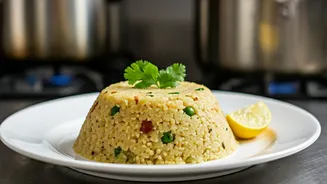Tamarind Rice
Tamarind rice, known as 'Puli Sadam' in Tamil, is a tangy and flavorful rice dish. The sourness comes from tamarind pulp, which is cooked with spices like
mustard seeds, urad dal, and red chilies. The rice is typically cooked separately and then mixed with the tamarind mixture. This dish is a staple in many South Indian homes and is often packed for lunch or eaten during travel. The preparation includes roasting the spices to enhance their flavor before mixing them with the tamarind pulp. Groundnuts are often added to provide a crunchy texture, making it a complete meal that can be enjoyed with papadums or a simple vegetable curry. The sour taste is balanced by a touch of sweetness, making it appealing for all palates. It is a quick and easy dish that requires minimal ingredients, making it an ideal choice for a quick lunch or dinner option.
Lemon Rice
Lemon rice, or 'Elumichai Saadam,' offers a refreshing taste with a zesty flavor profile. The key ingredient is fresh lemon juice, which infuses the rice with its characteristic tang. The dish is prepared by tempering mustard seeds, urad dal, and curry leaves in oil. This tempering, known as 'tadka,' provides an aromatic base for the rice. Once the tadka is ready, cooked rice is mixed with lemon juice and spices. Green chilies and sometimes peanuts can be added to the recipe to enhance the flavor. Lemon rice is particularly popular during religious festivals and is often offered as an offering to deities. Its lightness and refreshing taste make it a perfect accompaniment to heavier curries or as a standalone meal. The bright yellow color of the rice, obtained from turmeric powder, also makes it visually appealing and inviting.
Coconut Rice
Coconut rice is a creamy and aromatic dish, made by cooking rice in coconut milk. The rich flavor of coconut milk imparts a subtle sweetness and a delicate texture to the rice. Often, the rice is seasoned with spices like cardamom, cloves, and cinnamon to add warmth and complexity. The preparation involves toasting the spices to release their fragrance before incorporating them into the cooking process. Freshly grated coconut can be added to enhance the coconut flavor. This dish is often served with a variety of accompaniments, such as vegetable curries or meat dishes. Coconut rice is a staple in many South Indian households, particularly in coastal regions. Its simple yet elegant taste makes it a perfect addition to any meal, enhancing the overall dining experience with its smooth texture.
Curd Rice
Curd rice, known as 'Thayir Saadam' in Tamil, is a simple yet satisfying dish that is often served at the end of a meal. It is made by mixing cooked rice with curd (yogurt) and seasoning it with salt and spices. The dish is typically garnished with a tadka of mustard seeds, urad dal, and curry leaves. Some variations include adding chopped ginger, green chilies, or even finely chopped coriander leaves to enhance the flavors. Curd rice is known for its cooling properties and is especially appreciated during hot weather. It aids digestion and provides a soothing effect on the stomach. The creamy texture of curd rice is light and makes it a good balance to the richer and spicier curries that make up South Indian cuisine. It is a very easy and quick to prepare dish, perfect for a light lunch.
Tomato Rice
Tomato rice is a flavorful and colorful dish that combines the sweetness of tomatoes with aromatic spices. The preparation typically starts with sautéing onions, tomatoes, and a blend of spices such as turmeric, coriander, and chili powder. Once the tomatoes are cooked down, rice is added and cooked until it is tender and absorbs the flavors. Some recipes call for the addition of ginger-garlic paste for an enhanced taste. The vibrant color and tangy taste of the tomatoes make this a visually appealing dish. Tomato rice is often served with raita or papadums, and it can be a filling and satisfying meal. The versatility of tomato rice allows for variations, with some recipes including vegetables or other protein options.
Sambar Rice
Sambar rice combines the flavors of the South Indian stew, sambar, with rice. Cooked rice is mixed with sambar, a lentil-based vegetable stew, to create this comforting dish. The sambar provides a medley of vegetables, lentils, and spices, adding depth to the meal. The preparation of sambar involves cooking lentils, vegetables, and tamarind pulp with aromatic spices. The rice is then mixed with the sambar to absorb all its flavors. This dish is often garnished with coriander leaves. Sambar rice is a hearty and fulfilling meal, popular for its complex flavors and textures. It brings together the warmth of spices, the creaminess of lentils, and the comfort of rice, providing a balanced and satisfying dining experience. Sambar rice is often served alongside chutney.
Biryani
Biryani, a flavorful mixed rice dish, is a staple across India, with unique variations in the South. South Indian biryanis, such as Hyderabadi or Chettinad biryani, are renowned for their distinct flavors. The dish typically involves layering meat or vegetables with rice and a blend of aromatic spices, then slow-cooking them together. The meat or vegetables are marinated in a mixture of spices and yogurt, enhancing their flavors before being cooked. The rice is often partially cooked before being layered with the meat and spices, then finished off by dum pukht (slow steaming). The cooking method allows the flavors to meld, resulting in a rich and aromatic dish. Each region boasts its own biryani style, using local spices and ingredients, such as mint, coriander, and saffron. It offers a diverse range of taste experiences.
Pongal
Pongal, a traditional rice dish, is prepared with rice and lentils, cooked in milk. It is a staple in South Indian homes, particularly during festive occasions. Sweet pongal incorporates jaggery and is known as 'Sakkarai Pongal,' while savory pongal often includes cumin seeds, black peppercorns, and curry leaves. The dish is known for its simplicity and the use of basic ingredients. The preparation requires slowly cooking rice and lentils in milk until they reach a creamy consistency. The dish is cooked until the grains are soft and well-blended with the lentils and milk. The spices and seasonings are added to provide flavor. Pongal represents cultural significance. It can be served as a main dish or as a side, and the versatility of the dish allows for different variations and additions, such as dry fruits or cashews.
